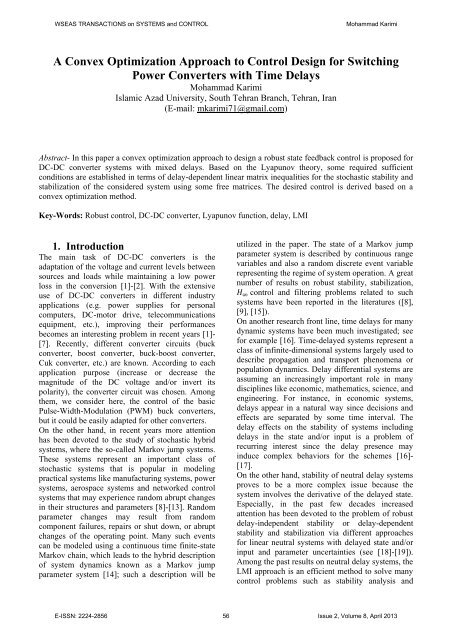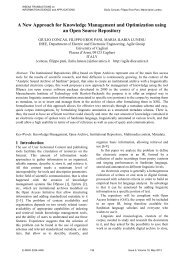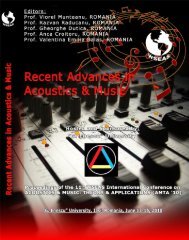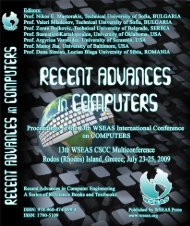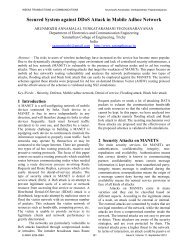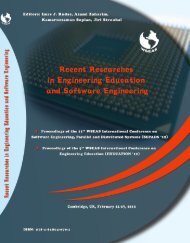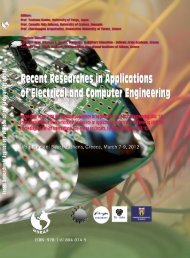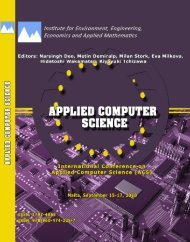A Convex Optimization Approach to Control Design for ... - WSEAS
A Convex Optimization Approach to Control Design for ... - WSEAS
A Convex Optimization Approach to Control Design for ... - WSEAS
Create successful ePaper yourself
Turn your PDF publications into a flip-book with our unique Google optimized e-Paper software.
<strong>WSEAS</strong> TRANSACTIONS on SYSTEMS and CONTROLMohammad KarimiA <strong>Convex</strong> <strong>Optimization</strong> <strong>Approach</strong> <strong>to</strong> <strong>Control</strong> <strong>Design</strong> <strong>for</strong> SwitchingPower Converters with Time DelaysMohammad KarimiIslamic Azad University, South Tehran Branch, Tehran, Iran(E-mail: mkarimi71@gmail.com)Abstract- In this paper a convex optimization approach <strong>to</strong> design a robust state feedback control is proposed <strong>for</strong>DC-DC converter systems with mixed delays. Based on the Lyapunov theory, some required sufficientconditions are established in terms of delay-dependent linear matrix inequalities <strong>for</strong> the s<strong>to</strong>chastic stability andstabilization of the considered system using some free matrices. The desired control is derived based on aconvex optimization method.Key-Words: Robust control, DC-DC converter, Lyapunov function, delay, LMI1. IntroductionThe main task of DC-DC converters is theadaptation of the voltage and current levels betweensources and loads while maintaining a low powerloss in the conversion [1]-[2]. With the extensiveuse of DC-DC converters in different industryapplications (e.g. power supplies <strong>for</strong> personalcomputers, DC-mo<strong>to</strong>r drive, telecommunicationsequipment, etc.), improving their per<strong>for</strong>mancesbecomes an interesting problem in recent years [1]-[7]. Recently, different converter circuits (buckconverter, boost converter, buck-boost converter,Cuk converter, etc.) are known. According <strong>to</strong> eachapplication purpose (increase or decrease themagnitude of the DC voltage and/or invert itspolarity), the converter circuit was chosen. Amongthem, we consider here, the control of the basicPulse-Width-Modulation (PWM) buck converters,but it could be easily adapted <strong>for</strong> other converters.On the other hand, in recent years more attentionhas been devoted <strong>to</strong> the study of s<strong>to</strong>chastic hybridsystems, where the so-called Markov jump systems.These systems represent an important class ofs<strong>to</strong>chastic systems that is popular in modelingpractical systems like manufacturing systems, powersystems, aerospace systems and networked controlsystems that may experience random abrupt changesin their structures and parameters [8]-[13]. Randomparameter changes may result from randomcomponent failures, repairs or shut down, or abruptchanges of the operating point. Many such eventscan be modeled using a continuous time finite-stateMarkov chain, which leads <strong>to</strong> the hybrid descriptionof system dynamics known as a Markov jumpparameter system [14]; such a description will beutilized in the paper. The state of a Markov jumpparameter system is described by continuous rangevariables and also a random discrete event variablerepresenting the regime of system operation. A greatnumber of results on robust stability, stabilization,control and filtering problems related <strong>to</strong> suchsystems have been reported in the literatures ([8],[9], [15]).On another research front line, time delays <strong>for</strong> manydynamic systems have been much investigated; see<strong>for</strong> example [16]. Time-delayed systems represent aclass of infinite-dimensional systems largely used <strong>to</strong>describe propagation and transport phenomena orpopulation dynamics. Delay differential systems areassuming an increasingly important role in manydisciplines like economic, mathematics, science, andengineering. For instance, in economic systems,delays appear in a natural way since decisions andeffects are separated by some time interval. Thedelay effects on the stability of systems includingdelays in the state and/or input is a problem ofrecurring interest since the delay presence mayinduce complex behaviors <strong>for</strong> the schemes [16]-[17].On the other hand, stability of neutral delay systemsproves <strong>to</strong> be a more complex issue because thesystem involves the derivative of the delayed state.Especially, in the past few decades increasedattention has been devoted <strong>to</strong> the problem of robustdelay-independent stability or delay-dependentstability and stabilization via different approaches<strong>for</strong> linear neutral systems with delayed state and/orinput and parameter uncertainties (see [18]-[19]).Among the past results on neutral delay systems, theLMI approach is an efficient method <strong>to</strong> solve manycontrol problems such as stability analysis andE-ISSN: 2224-2856 56 Issue 2, Volume 8, April 2013
<strong>WSEAS</strong> TRANSACTIONS on SYSTEMS and CONTROLMohammad Karimistabilization [20] and control problems [21]-[24]. It is also worth citing that some appreciableworks have been per<strong>for</strong>med <strong>to</strong> design a guaranteedcost(observer-based) control <strong>for</strong> the neutral systemper<strong>for</strong>mance representation [25]-[27].In this paper, we are concerned <strong>to</strong> develop a robustcontrol problem <strong>for</strong> Markovian switchingsystems with mixed discrete, neutral and distributeddelays. The main merit of the proposed method isthe fact that it provides a convex problem such thedelay-dependent control gains can be found fromthe LMI <strong>for</strong>mulations. Some required sufficientconditions are established in terms of LMIscombined with the Lyapunov-Krasovskii method <strong>for</strong>the existence of the desired control. Numericalexamples are given <strong>to</strong> illustrate the use of our results<strong>for</strong> a DC-DC converter model.Notation: The notations used throughout the paperare fairly standard. and represent identity matrixand zero matrix; the superscript stands <strong>for</strong> matrixtransposition. ‖ ‖ refers <strong>to</strong> the Euclidean vec<strong>to</strong>rnorm or the induced matrix 2-norm.represents a block diagonal matrix and the opera<strong>to</strong>r( ) represents . Let ) anddenotes the expectation opera<strong>to</strong>r with respect <strong>to</strong>some probability measure . If ( ) is a continuous-valued s<strong>to</strong>chastic process on), we let( ) <strong>for</strong> which isregarded as a ( ] )-valued s<strong>to</strong>chasticprocess. The notation means that is realsymmetric and positive definite; the symbol denotes the elements below the main diagonal of asymmetric block matrix.2. Problem DescriptionConsider a class of uncertain time-delay systemswith Markovian switching parameters and mixedneutral, discrete and distributed delays and normboundedtime-varying uncertainties represented byx(t) A (r(t)) x(t d) (A (r(t)) A (t,(r(t)))) x(t) (A (r(t)) A (t,(r(t)))) x(t h) (A (r(t)) A3(t,(r(t)))) x(s) ds (A5(r(t)) A4(t,(r(t)))) x(t d) (B (r(t)) B (t,(r(t)))) u(t) (B (r(t)) B (t,(r(t)))) w(t),12412tt1x(t) (t),t ,0r(t) r0 , t ,0z(t) C(r(t)) x(t) C (r(t))x(t d) C (r(t))x(t h)t C(r(t)) x(s) dsD(r(t))u(t),td(1a)(1b)(1c)(1d)nmwhere x(t), u(t)s, andz(t)z2are state, input, disturbance and controlled1 w(t) L [0, )3h22 output,Crespectively.id (r(t)),Ch(r(t)),C(r(t))))and D(r(t are matrixfunctions of the random jumping process {r(t)} .{ r(t), t 0} is a right-continuous Markov process onthe probability space which takes values in a finitespace S {1,2, ,s}with genera<strong>to</strong>r [ ij ] (i, jS)given by ij o( ),if i jP{r(t ) jr(t) i} 1 ii o( ),if i j(2)where 0 , lim 0 o( )/ 0 and , <strong>for</strong> ,is the transition rate from mode i at time t <strong>to</strong> modejat time t and .The time-varyingfunction (t) is continuous vec<strong>to</strong>r valued initialfunction and h,dand are constant time delayswith . Moreover, the normboundeduncertainties are defined as follows:(3a)(3b)where (t,r(t)) is the uncertain time-varying matrixfunction of the random jumping process, whichsatisfies T (t,r(t)) (t,r(t)) I <strong>for</strong> t 0; r(t) iSandE i (r(t)) and H 1 (r(t))are known real constantmatrices of the random jumping process withappropriate dimensions.Definition 1. Uncertain time-delay system (1) withMarkovian switching parameter in (2) is said <strong>to</strong> bes<strong>to</strong>chastically mean square stable if, when ( ) ,<strong>for</strong> any finite ( ) defined on ], andthe following condition is satisfied‖ ( )‖A (r(t)),B (r(t)),C(r(t)),ij 0j sijj1,jiA(t,r(t)) H (r(t)) (t,r(t))E(r(t)),i1B(t,r(t)) H (r(t)) (t,r(t))Ej1‖ ( )‖where ( ) is the trajec<strong>to</strong>ry of the system state frominitial system state ( ) and initial mode , andis a positive constant.Definition 2. The per<strong>for</strong>mance measure of thesystem (1) is defined as (∫ ( ) ( )( ) ( )] ), where the positive scalar isgiven.Assumption 1. The full state variableavailable <strong>for</strong> measurement.iii4j(r(t)),ii 1,2,,4j 1,2( ) isE-ISSN: 2224-2856 57 Issue 2, Volume 8, April 2013
<strong>WSEAS</strong> TRANSACTIONS on SYSTEMS and CONTROLMohammad KarimiIn this paper, the author’s attention will be focusedon the design of the following robust modedependentdelayed state feedback control law,( ) ( ) ( )∫ ( )(4)where the matrices of theappropriate dimension is <strong>to</strong> be determined such that<strong>for</strong> any ( ) the resulting closed-loopsystem is s<strong>to</strong>chastically stable and satisfies annorm bound , i.e. .3. Main ResultsIn this section, we first investigate both thes<strong>to</strong>chastic stability and per<strong>for</strong>mance of thesystem (1) with norm-bounded uncertaintyparameters. A new delay-dependent s<strong>to</strong>chasticstability condition by a discretization technique isproposed in Theorem 1. Then, we will show theprocedure <strong>to</strong> design the controller gains, which guarantee the resulting closedloopsystem is s<strong>to</strong>chastically stable and satisfies annorm bound .We choose a s<strong>to</strong>chastic Lyapunov-Krasovskiifunctional candidate ( )aswhereV(x,x 4 t ,t,i) V i (x,xt,t,i)i10TT1xt, t,i) x(t) P1ix(t) 2 x(t) Q(i) x(t )dhV (x,V (x, x , t,i) 3tV2(x, xt, t,i) x(s)0 0 x(t s)4ddV (x, xtt0 0 x(t s) x(s) td,t, i)hhTTthSx(s) ds R x(t )ds d, ,(5)Theorem 1. The time-delay system (1) withMarkovian switching parameters in (2) and withoutthe norm-bounded uncertainties in (3) iss<strong>to</strong>chastically mean square stable with anper<strong>for</strong>mance level , if there exist somematrices , , andTTU x(s) 1ds x(t )T x(t )ds d, [ x( )t ( t s) x( )0 tstttsT0dd] UT2UT[ x( )d]2tsx( )H x(t )dddsdspositive definite matrices () satisfying the following LMIsP1iQi 0 , (6a) R Sei 1i(Pwhere [ ] andProof. See [28].TTT P2iA2i Qi C C i hi diag{CiCi,0} T P3iA2i T S C CT2i PTP3iA0TA P A4i U)AP( [ ]) {∑( ) }Remark 1. Note that the matrix1i1i4i14i4i[ ] UTPB 2i 2i T P3iB2i0 0 00 0 2 I(6b)(or, equivalently, the matrix ) is non-singular due<strong>to</strong> the fact that the only matrix which can benegative definite in the first block on the diagonal ofLMI (6b) is .Remark 2. If the switching modes are notconsidered, i.e. S {1} , the jump linear system issimplified in<strong>to</strong> a general linear system withnonlinearities and time delays. Then it is easy <strong>to</strong>conclude a criterion from Theorem 1, which can beused <strong>to</strong> determine the stability of such a system.In the following, we present a condition <strong>for</strong> thestability of the time-delay system (1) withMarkovian switching parameters in (2) and normboundeduncertainties in (3).T2iCATP3iA0Ti3iC C00ihi3iTihiC2sT T 2i P 2iA5i CiCdi ( ijP1j Qi0)A4ij1isTT3i CdiCdi H A4iijP1jA4ij1 2i TP3iA0,,3i5iE-ISSN: 2224-2856 58 Issue 2, Volume 8, April 2013
<strong>WSEAS</strong> TRANSACTIONS on SYSTEMS and CONTROLMohammad KarimiTheorem 2. Under Assumption 1, a state feedbackcontroller given in the <strong>for</strong>m (4) exists such that thetime-delay system (1) with Markovian switchingparameters in (2) is s<strong>to</strong>chastically stable with anper<strong>for</strong>mance level , if there exist some scalars, matrices ̅ ̃ ̃ , ̃ ̃ ̃̃ ,, and positive definite matrices̃ ̃ ̃ ̃ (following LMIs) satisfying the~P Qˆ 1ii 0 , Rˆ Ŝ(7a)ˆˆ ˆeidi ei iI 0 0iI (7b)where ̂ ] ̂̂̃[where([] and̃̃̃( )̃]])be designed as ̅ ̅̅̅Proof. See [28].Remark 3. By setting and minimizingsubject <strong>to</strong> LMIs (26), we can obtain the optimalper<strong>for</strong>mance level (by √ ) and thecorresponding control gains as well.4. DC-DC convertersThere are three kinds of switching mode DC-DCconverters, buck, boost and buck-boost. The buckmode is used <strong>to</strong> reduce output voltage, whilst theboost mode can increase the output voltage. In thebuck-boost mode, the output voltage can bemaintained either higher or lower than the sourcebut in the opposite polarity. The simplest <strong>for</strong>ms ofthese converters are schematically represented inFigure 1. These converters consist of the samecomponents, an induc<strong>to</strong>r, L, a capaci<strong>to</strong>r, C and aswitch, which has two states u = 1 and u = 0. Allconverters connect <strong>to</strong> a DC power source with avoltage (unregulated), and provide a regulatedvoltage, <strong>to</strong> the load resis<strong>to</strong>r, R by controlling thestate of the switch. In some situations, the load alsocould be inductive, <strong>for</strong> example a DC mo<strong>to</strong>r, orapproximately, a current load, <strong>for</strong> example in acascade configuration. For simplicity, here, onlycurrent and resistive loads are <strong>to</strong> be considered.∑ ̃ ( ̃ )[̃ ̃ ̃ ̃̃],( )(a) Boost[[(∑ ̃ ̃ )],(∑ ̃ ̃ ))̃],(b) Buck[], [ ],( )[ ]and ̃ ( ) ∑ ̃ ,, ,( ). Moreover, the controller gains in (4) can(c) Buck-boostFigure 1. Switching-mode DC-DC converters: (a)buck, (b) boost and (c) buck-boost.E-ISSN: 2224-2856 59 Issue 2, Volume 8, April 2013
v c(t)<strong>WSEAS</strong> TRANSACTIONS on SYSTEMS and CONTROLMohammad Karimi5. Averaged model of Basic PWMbuck converterFigure 1 shows the basic circuit of the nonlinearPWM buck converter proposed in [3]-[4] with anexternal disturbance ( ) as proposed in [1]-[2].is the on-state resistance of the MOSFETtransis<strong>to</strong>r, is the winding resistance of induc<strong>to</strong>r,is the threshold voltage of the diode and isthe equivalent series resistance of the filtercapaci<strong>to</strong>r. By applying the Kirchhoff’s voltage law(KVL) and Kirchhoff’s current law (KCL) in onstateof the MOSFET transis<strong>to</strong>r case, we obtain[29]:1 (Rl R Rc) i(t) lil(t d) L E v(t) v (t d) R Rccc CRc 1(V Lin R0 R Rc il(t)) L R R CRc ic10 RRcwhere E and R Rc . 0 c2R Rcm R RLRc R RCRRFigure 2. Schematic of a basic PWM buckconverter.(8)Now, in off-state of the MOSFET transis<strong>to</strong>r caseand by applying of KVL and KCL, we get:1 R Rc (Rl R Rc) i(t) i (t d) LLR il(t)ll c E v (t) v (t d) R Rc R Rc vc(t)cc CRcCRRc R Rc Vd LL iload(t) R R0 c CR c (9)Using Averaging Method of on One Time ScaleDiscontinuous system (AM-OTS-Ds) [30], thecload(t)ccc il(t) vc(t) global dynamical behavior of the DC-DC converteris modeled as:1 R Rc (Rl R Rc) i(t) i (t d) LLR il(t)ll c E v (t) v (t d) R Rc R Rc vc(t)cc CRcCRRc R Rc Vd Vin Vd Rmil(t) d(t)LL L iload(t)R Rc0 0 CR c (10)where ( ) is the duty cycle.6. Simulation resultsIn this section, with the aid of MATLAB LMIToolbox [31], we use the averaged model of BasicPWM buck converter <strong>to</strong> illustrate the effectivenessand advantage of our design method. In thissimulation, the PWM frequency equals <strong>to</strong> 1 kHz.The simulation parameters used in this work are asfollows [3]:with the input current i load 0.25sin(1000t) . The DC-DC converter parameters are switching between twomodes, i.e., 1.0 and 1.2 nominal values, under (8a) thefollowing Markovian transition matrix[ ].The optimization problem described in (7) is solved<strong>for</strong> initial condition x 0 0 , h=15 ms and c=0.3.Responses of the output voltage of PWM buckconverter and the inductance current of PWM buckconverter are, respectively, plotted in Fig. 3 and Fig.4.3020100-100 0.05 0.1 0.15 0.2t[s]Figure 3. Response of the output voltage of PWMbuck converterE-ISSN: 2224-2856 60 Issue 2, Volume 8, April 2013
i l(t)<strong>WSEAS</strong> TRANSACTIONS on SYSTEMS and CONTROLMohammad Karimi1510500 0.05 0.1 0.15 0.2t[s]Figure 4. Response of the inductance current ofPWM buck converter.7. ConclusionThe problem of robust state feedback controlwas proposed <strong>for</strong> a class of Markovian swtichingsystems with mixed discrete, neutral anddistributed delays. Some required sufficientconditions were derived in terms of delaydependentLMIs using some free matrices and theLyapunov-Krasovskii functional theory. Thedesired control is derived based on a convexoptimization method. Numerical examples weregiven <strong>to</strong> illustrate the use of our results <strong>for</strong> a DC-DC converter model.References[1] C.Olalla, R. Leyva, A. El Aroudi, I. Queinnec, S.Tarbouriech, <strong>Control</strong> of DC-DC ConvertersConverters with Saturated Inputs, IEEE Conf.on Industrial Electronics, IECON'09, Por<strong>to</strong>,2009.[2] C. Olalla , I. Queinnec, R. Leyva, A. ElAroudi,Robust optimal control of bilinear DC–DCconverters, <strong>Control</strong> Eng. Practice, In Press,2011.[3] Y. Li, Z. Ji, T-S Modeling, Simulation and<strong>Control</strong> of the Buck onverter, 5 th Inter.Conference on Fuzzy Systems and KnowledgeDiscovery, 18-20 Oct. 2008, Schandong, China,pp. 663-667.[4] K. Y. Lian, J.J. Liou, LMI-based integral fuzzycontrol of DC-DC converters, IEEE transactionon Fuzzy System, 14(2006), 71-80.[5] D. Cortés, Jq. Alvarez, Ja. Alvarez-Gallegos,Feed<strong>for</strong>ward and feedback robust control of thebuck converter, 15 th World IFAC Congress,Barcelona, Spain, (2002).[6] I. Gadoura, T. Suntio, K. Zenger, Roubustcontrol design <strong>for</strong> paralleled DC/Dc converterswith current sharing, 15 th World IFACCongress, Spain (2002).[7] D. Alejo, P. Maussion, J. Fauche1, Multiplemodel control of a Buck DC/DC converter,Mathematics and Computers in Simulation 63(2003) 249–260.[8] Boukas, E.K., and Benzaouia, A.. Stability ofdiscrete-time linear systems with Markovianjumping parameters and constrained control.IEEE Transactions on Au<strong>to</strong>matic <strong>Control</strong>, 47(3),516-521, 2002.[9] Shi, P., and Boukas, E.K.. control <strong>for</strong>Markovian jumping linear systems withparametric uncertainty. Journal of <strong>Optimization</strong>Theory and Applications, 95(1), 75-99, 1997.[10] Shi, P., Boukas, E. K., and Agarwal, K..Kalman filtering <strong>for</strong> continuous-time uncertainsystems with Markovian jumping parameters.IEEE Transactions on Au<strong>to</strong>matic <strong>Control</strong>, 44(8),1592-1597, 1999.[11] Shi, P., Boukas, E. K., and Agarwal, K..<strong>Control</strong> of Markovian jump discrete-timesystems with norm bounded uncertainty andunknown delay. IEEE Trans. on Au<strong>to</strong>matic<strong>Control</strong>, 44(11), 2139-2144, 1999.[12] Shi, P., Xia, Y., Liu, G. P., and Rees, D.. Ondesigning of sliding-mode control <strong>for</strong> s<strong>to</strong>chasticjump systems. IEEE Transactions on Au<strong>to</strong>matic<strong>Control</strong>, 51(1), 97_103, 2006.[13] Wang Z., Lam J., Liu X., ‘Exponential filtering<strong>for</strong> uncertain Markovian jump time-delaysystems with nonlinear disturbances’ IEEETrans. Circuits and Systems, II: Express Briefs,51(5), 262-268, 2004.[14] Mari<strong>to</strong>n, M.. Jump linear systems in au<strong>to</strong>maticcontrol. New York: Marcel Dekker Inc, 1990.[15] Saif A.W., Mahmoud M.S. and Shi Y., ‘Aparameterized delay-dependent control ofswitched discrete-time systems with time-delay,’Int. J. Innov. Comput., In<strong>for</strong>mation and <strong>Control</strong>,5(9), 2893-2906, 2009.[16] Niculescu S. I., Delay Effects on Stability: ARobust <strong>Control</strong> <strong>Approach</strong> (Berlin: Springer),2001.[17] Gu K., Khari<strong>to</strong>nov V.L., and Chen J., ‘Stabilityof time-delay systems’ Birkhauser, Bos<strong>to</strong>n, 2003,ISBN 0-8176-4212-9.[18] Ivansecu, D., Niculescu S.I., Dugard L., DionM. and Verriest E.I., ‘On delay-dependentstability of linear neutral systems’, Au<strong>to</strong>matica,39, 255-261, 2003.[19] Lam, J., Gao, H., and Wang, C., ‘ modelreduction of linear systems with distributeddelay.’ IEE Proc. <strong>Control</strong> Theory Appl., 152(6),662-674, 2005.[20] Fridman, E., ‘New Lyapunov-Krasovskiifunctionals <strong>for</strong> stability of linear retarded andneutral type systems.’ Systems and <strong>Control</strong>Letters, 43, 309-319, 2001.[21] Fridman, E., and Shaked, U., ‘Delay-dependentstability and control: constant and time-E-ISSN: 2224-2856 61 Issue 2, Volume 8, April 2013
<strong>WSEAS</strong> TRANSACTIONS on SYSTEMS and CONTROLMohammad Karimivarying delays.’ International Journal of<strong>Control</strong>, 76, 48-60, 2003.[22] Gao, H., and Wang, C., ‘Comments and furtherresults on ‘A descrip<strong>to</strong>r system approach <strong>to</strong>control of linear time-delay systems.’ IEEETransactions on Au<strong>to</strong>matic control, 48, 520-525,2003.[23] Zhao Y., Gao H., Lam J. and Du B., Stabilityand stabilization of delayed T-S fuzzy systems:A delay partitioning approach. IEEE Trans. onFuzzy Systems, 17(4), 750-762, 2009.[24] Karimi H.R. and Gao H., ‘New delaydependentexponential synchronization <strong>for</strong>uncertain neural networks with mixed timedelays’IEEE Trans. on Systems, Man andCybernetics-B, 40(1), 173-185, 2010.[25] Chen, B., Lam, J., and Xu, S., ‘Memory statefeedback guaranteed cost control <strong>for</strong> neutralsystems’ Int. J. Innovative Computing,In<strong>for</strong>mation and <strong>Control</strong>, 2(2), 293-303, 2006.[26] Park J.H., ‘Guaranteed cost stabilization ofneutral differential systems with parametricuncertainty’ J. Computational and Appliedmathematics, 151, 371-382, 2003.[27] Lien, C.H., ‘Guaranteed cost observer-basedcontrols <strong>for</strong> a class of uncertain neutral timedelaysystems.’ J. <strong>Optimization</strong> Theory andApplications, 126(1), 137-156, 2005.[28] H.R. Karimi, Robust Delay-Dependent<strong>Control</strong> of Uncertain Markovian Jump Systemswith Mixed Neutral, Discrete and DistributedTime-Delays, IEEE Trans. Circuits and SystemsI, 58(8), 1910-1923, 2011.[29] J. Sun, H. Grots<strong>to</strong>llen, Averaged modelling ofswitching power converters: Re<strong>for</strong>mulation andtheoretical basis, Power electronics specialistsconf., 29-03 jul 1992, Taledo, Spain, pp. 1165-1172.[30] Bellen A., Guglielmi N., and Ruehli A.E.,‘Methods <strong>for</strong> linear systems of circuit delaydifferential equations of neutral type’ IEEETrans. on Circuits and Systems-I, 46(1), 212-216, 1999.[31] P. Gahinet, A. Nemirovsky, A.J. Laub, and M.Chilali, ‘LMI control Toolbox: For use withMatlab.’ Natik, MA: The MATH Works, Inc.,1995.E-ISSN: 2224-2856 62 Issue 2, Volume 8, April 2013


